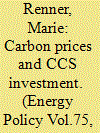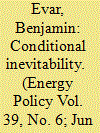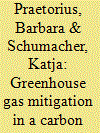|
|
|
Sort Order |
|
|
|
Items / Page
|
|
|
|
|
|
|
| Srl | Item |
| 1 |
ID:
136242


|
|
|
|
|
| Summary/Abstract |
Carbon Capture and Storage is considered as a key option for climate change mitigation; policy makers and investors need to know when CCS becomes economically attractive. Integrating CCS in a power plant adds significant costs which can be offset by a sufficient CO2 price. However, most markets have failed: currently, the weak carbon price threatens CCS deployment in the European Union (EU). In China, a carbon regulation is appearing and CCS encounters a rising interest. This study investigates two questions: how much is the extra-cost of a CCS plant in the EU in comparison with China? Second, what is the CO2 price beyond which CCS plants become more profitable than reference plants in the EU and in China? To address these issues, I conducted a literature review on public studies about CCS costs. To objectively assess the profitability of CCS plants, I constructed a net present value model to calculate the Levelised Cost of Electricity and the breakeven CO2 price. CCS plants become the most profitable plant type beyond 115 €/tCO2 in the EU vs. 45 €/tCO2 in China (offshore transport and storage costs). I advise on the optimal plant type choice depending on the CO2 price in both countries.
|
|
|
|
|
|
|
|
|
|
|
|
|
|
|
|
| 2 |
ID:
105759


|
|
|
|
|
| Publication |
2011.
|
| Summary/Abstract |
This paper presents findings on expert perceptions of uncertainty in carbon capture and storage (CCS) technology and policy in the UK, through survey data and semi-structured interviews with 19 individual participants. Experts were interviewed in industry, research, and non-governmental organisations (NGOs) in the summer of 2009 and were asked to comment on a range of technical processes as well as policy concerns. The survey revealed that perceptions of the technology conform to a 'certainty trough' with users expressing the lowest level of uncertainty, and outsiders expressing the highest level of uncertainty. The interviews revealed that experts express certitude in the prospects for deploying large-scale CCS technology in the UK, all the while questioning several underlying technical and policy premises that are necessary to ensure this goal.
|
|
|
|
|
|
|
|
|
|
|
|
|
|
|
|
| 3 |
ID:
105746


|
|
|
|
|
| Publication |
2011.
|
| Summary/Abstract |
Climate change mitigation and security of energy supply are important targets of Austrian energy policy. Bioenergy production based on resources from agriculture and forestry is an important option for attaining these targets. To increase the share of bioenergy in the energy supply, supporting policy instruments are necessary. The cost-effectiveness of these instruments in attaining policy targets depends on the availability of bioenergy technologies. Advanced technologies such as second-generation biofuels, biomass gasification for power production, and bioenergy with carbon capture and storage (BECCS) will likely change the performance of policy instruments. This article assesses the cost-effectiveness of energy policy instruments, considering new bioenergy technologies for the year 2030, with respect to greenhouse gas emission (GHG) reduction and fossil fuel substitution. Instruments that directly subsidize bioenergy are compared with instruments that aim at reducing GHG emissions. A spatially explicit modeling approach is used to account for biomass supply and energy distribution costs in Austria. Results indicate that a carbon tax performs cost-effectively with respect to both policy targets if BECCS is not available. However, the availability of BECCS creates a trade-off between GHG emission reduction and fossil fuel substitution. Biofuel blending obligations are costly in terms of attaining the policy targets.
|
|
|
|
|
|
|
|
|
|
|
|
|
|
|
|
| 4 |
ID:
098656


|
|
|
|
|
| Publication |
2010.
|
| Summary/Abstract |
This study models the costs of electricity generation with carbon capture and sequestration (CCS), from generation at the power plant to carbon injection at the reservoir, examining the economic factors that affect technology choice and CCS costs at the individual plant level. The results suggest that natural gas and coal prices have profound impacts on the carbon price needed to induce CCS. To extend previous analyses we develop a "cost region" graph that models technology choice as a function of carbon and fuel prices. Generally, the least-cost technology at low carbon prices is pulverized coal, while intermediate carbon prices favor natural gas technologies and high carbon prices favor coal gasification with capture. However, the specific carbon prices at which these transitions occur is largely determined by the price of natural gas. For instance, the CCS-justifying carbon price ranges from $27/t CO2 at high natural gas prices to $54/t CO2 at low natural gas prices. This result has important implications for potential climate change legislation. The capital costs of the generation and CO2 capture plant are also highly important, while pipeline distance and criteria pollutant control are less significant.
|
|
|
|
|
|
|
|
|
|
|
|
|
|
|
|
| 5 |
ID:
092733


|
|
|
|
|
| Publication |
2009.
|
| Summary/Abstract |
Carbon capture and storage (CCS) promises to allow for low-emissions fossil-fuel-based power generation. The technology is under development; a number of technological, economic, environmental and safety issues remain to be solved. CCS may prolong the prevailing coal-to-electricity regime and countervail efforts in other mitigation categories. Given the need to continue using fossil-fuels for some time, however, it may also serve as a bridging technology towards a renewable energy future. In this paper, we analyze the structural characteristics of the CCS innovation system and perform an energy-environment-economic analysis of the potential contribution of CCS, using a general equilibrium model for Germany. We show that a given climate target can be achieved at lower marginal costs when the option of CCS is included into the mix of mitigation options. We conclude that, given an appropriate legal and policy framework, CCS, energy efficiency and some other mitigation efforts are complementary measures and should form part of a broad mix of measures required for a successful CO2 mitigation strategy.
|
|
|
|
|
|
|
|
|
|
|
|
|
|
|
|
| 6 |
ID:
179737


|
|
|
|
|
| Summary/Abstract |
Carbon capture, utilization and storage (CCUS) represents a set of technologies essential to meeting ambitious mid-to late-century decarbonization goals. Yet deployment of CCUS has been slow, with fewer than 20 large-scale facilities operating worldwide in 2019. We estimate the total and marginal cost of constructing and operating new CCUS facilities and associated infrastructure to reduce carbon dioxide (CO2) emissions from current and planned industrial facilities on the Texas and Louisiana Gulf Coast. We compare these cost estimates to scheduled CCUS tax incentives through 2026 under section 45Q of the U.S. Internal Revenue Code to quantify cost-effective emissions abatement. Our analysis measures the cost-reducing potential of economies of scale in regional CO2 pipeline networks. We also compare CCUS costs to one measure of the benefits of carbon capture, the social cost of carbon. Results suggest that U.S. federal tax incentives currently in place through 2026 could justify between 3.3 million and 77.6 million tons of annual CCUS in the Gulf region, depending on the choice of storage technology and the degree of pipeline network coordination. Finally, we highlight several potential policy barriers that may explain low adoption of CCUS in the Gulf Region and elsewhere.
|
|
|
|
|
|
|
|
|
|
|
|
|
|
|
|
| 7 |
ID:
094403


|
|
|
|
|
| Publication |
2010.
|
| Summary/Abstract |
This paper analyzes the potential contribution of carbon capture and storage (CCS) technologies to greenhouse gas emissions reductions in the U.S. electricity sector. Focusing on capture systems for coal-fired power plants until 2030, a sensitivity analysis of key CCS parameters is performed to gain insight into the role that CCS can play in future mitigation scenarios and to explore implications of large-scale CCS deployment. By integrating important parameters for CCS technologies into a carbon-abatement model similar to the EPRI Prism analysis (EPRI, 2007 ), this study concludes that the start time and rate of technology diffusion are important in determining emissions reductions and fuel consumption for CCS technologies. Comparisons with legislative emissions targets illustrate that CCS alone is very unlikely to meet reduction targets for the electric-power sector, even under aggressive deployment scenarios. A portfolio of supply and demand-side strategies is needed to reach emissions objectives, especially in the near term. Furthermore, model results show that the breakdown of capture technologies does not have a significant influence on potential emissions reductions. However, the level of CCS retrofits at existing plants and the eligibility of CCS for new subcritical plants have large effects on the extent of greenhouse gas emissions reductions.
|
|
|
|
|
|
|
|
|
|
|
|
|
|
|
|
| 8 |
ID:
105733


|
|
|
|
|
| Publication |
2011.
|
| Summary/Abstract |
Carbon Capture and Storage (CCS) is the critical enabling technology that would reduce CO2 emissions significantly while also allowing fossil fuels to meet the world's pressing energy needs. The International Energy Agency analysis shows that although the developed world must lead the CCS effort in the next decade, there is an urgent need to spread CCS to the developing world. Given technologies for reducing GHG emissions originate mainly in developed countries, technology transfer, as an important feature emphasized by both the United Nations Framework Convention on Climate Change (UNFCCC) and the Kyoto Protocol, therefore has a key role to play in bridging a gap between developed and developing countries. The main objective of this paper is to explore potential policies and schemes promoting the transfer of CCS technologies to developing countries. First, it reviews the global CCS status, analyzes the significant gap of CCS in developed and developing countries, and investigates stakeholder perceptions of diffusing CCS to China, which is a major developing country and a significant potential candidate for large-scale CCS deployment; then the authors make an attempt to understand technology transfer including its benefits, barriers, and definition. The UNFCCC explicitly commits the developed (Annex I) countries to provide financial and technical support to developing countries under favorable terms. The authors argue that the ultimate goal of technology transfer should not only be limited to apply CCS in developing countries, but also to enhance their endogenous capabilities, which will enable future innovation and ensure long-term adoption of low-carbon technologies. As a result, the authors propose a four-pronged approach to the transfer of CCS technologies, which involves physical transfer of explicit technologies, a financial mechanism, endogenous capacity building, and a monitoring mechanism. Concrete enhanced actions to promote CCS technology transfer are also proposed. The four-pronged approach and related enhanced actions proposed in this paper are also applicable to other low-carbon technology transfer.
|
|
|
|
|
|
|
|
|
|
|
|
|
|
|
|
| 9 |
ID:
125657


|
|
|
|
|
| Publication |
2013.
|
| Summary/Abstract |
Cement is the second largest anthropogenic emission source, contributing approximately 7% of global CO2 emissions. Carbon dioxide capture and storage (CCS) technology is considered by the International Energy Agency (IEA) as an essential technology capable of reducing CO2 emissions in the cement sector by 56% by 2050. The study compares CO2 capture technologies for the cement manufacturing process and analyses the economic and financial issues in deploying CO2 capture in the cement industry. Post-combustion capture with chemical absorption is regarded as a proven technology to capture CO2 from the calcination process. Oxyfuel is less mature but Oxyfuel partial capture-which only recycles O2/CO2 gas in the precalciner-is estimated to be more economic than post-combustion capture. Carbonate looping technologies are not yet commercial, but they have theoretical advantages in terms of energy consumption. In contrast with coal-fired power plants, CO2 capture in the cement industry benefits from a higher concentration of CO2 in the flue gas, but the benefit is offset by higher SOx and NOx levels and the smaller scale of emissions from each plant. Concerning the prospects for financing cement plant CO2 capture, large cement manufacturers on average have a higher ROE (return on equity) and lower debt ratio, thus a higher discount rate should be considered for the cost analysis than in power plants. IEA estimates that the incremental cost for deploying CCS to decarbonise the global cement sector is in the range US$350-840 billion. The cost estimates for deploying state-of-the art post-combustion CO2 capture technologies in cement plants are above $60 to avoid each tonne of CO2 emissions. However, the expectation is that the current market can only provide a minority of financial support for CO2 capture in cement plants. Public financial support and/or CO2 utilisation will be essential to trigger large-scale CCS demonstration projects in the cement industry.
|
|
|
|
|
|
|
|
|
|
|
|
|
|
|
|
|
|
|
|
|